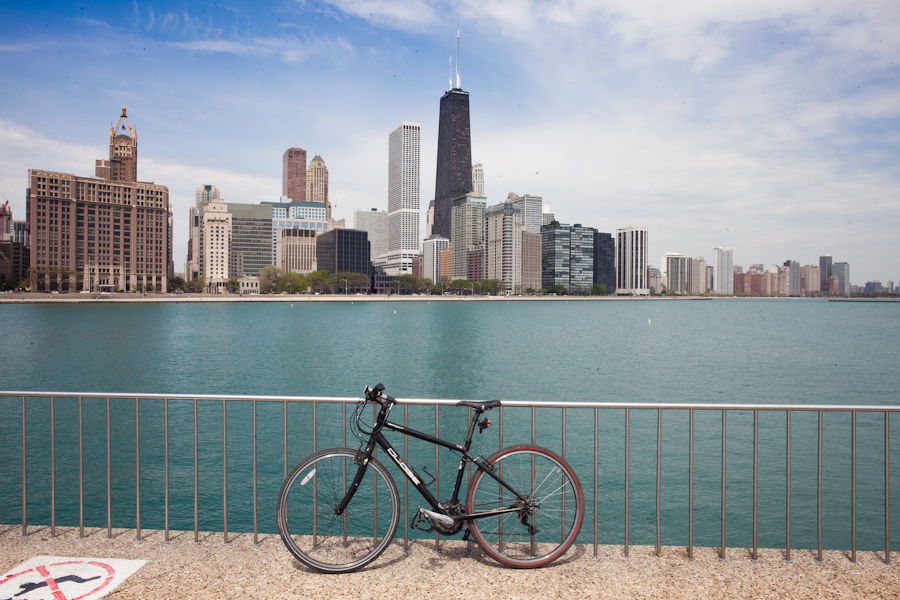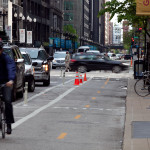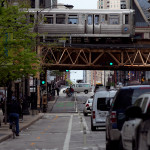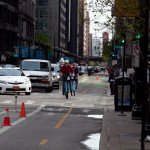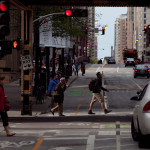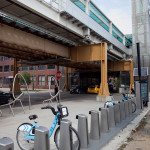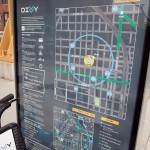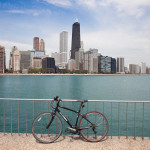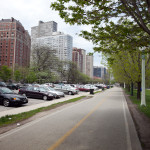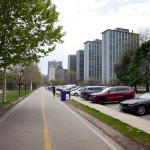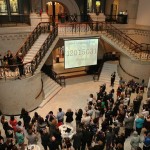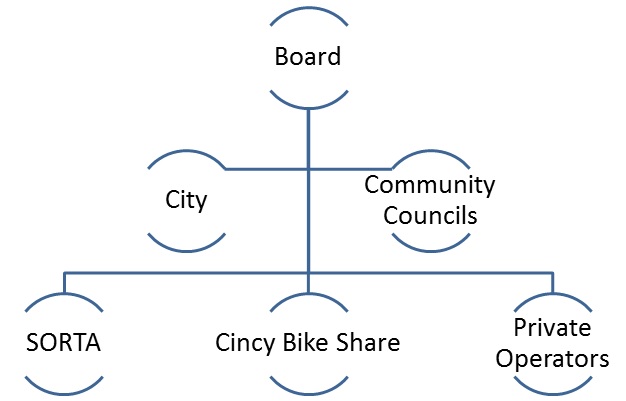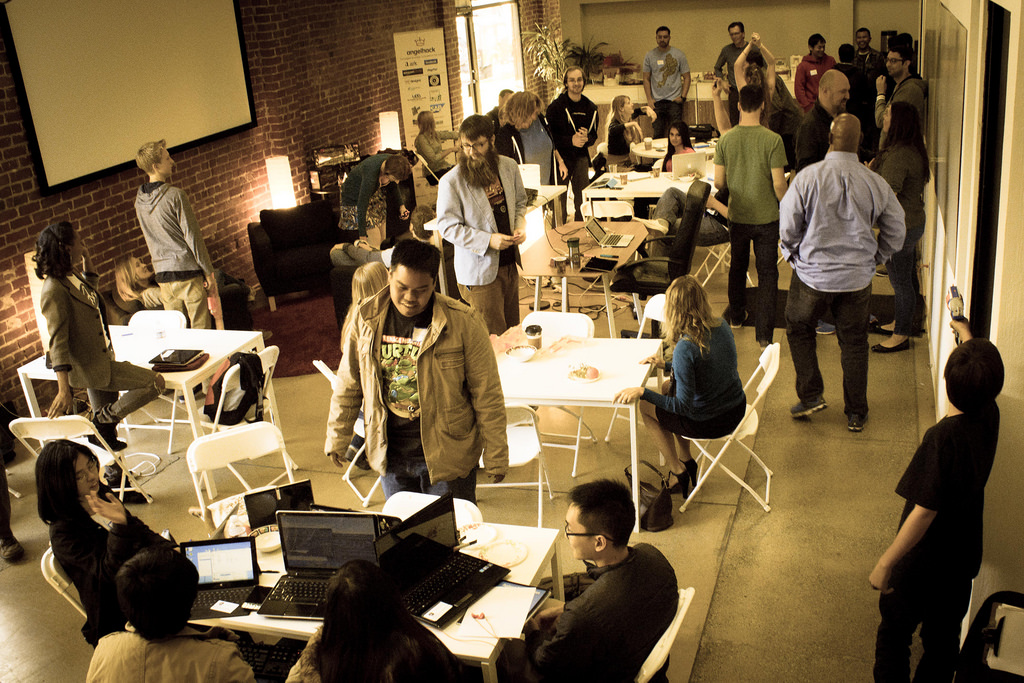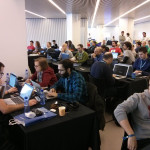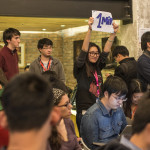For the past few years anyone with an interest in bicycling has seen their Facebook and Twitter feeds stuffed daily with bike lane and bike share project updates from cities around the United States. Much of that news has come from our northern neighbor Chicago, where its first of 100 planned miles of protected bike lanes opened in 2012.
In 2013 Chicago also launched the nation’s third-largest bike share program, a 300-station network sprawling across large sections of the city. Then, in early 2014, construction began on the $60 million Navy Pier Flyover, an elevated structure that will speed Lakefront Trail bicycle traffic over the Chicago River and the congested Navy Pier tourist area.
In May I spent part of a vacation day biking 35 miles around Chicago to see its various recent bicycling improvements for myself. This ride included The Loop, parts of the Lakefront Trail, and various residential areas where bike lanes have been recently created.
Dearborn Street Two-Way Protected Bike Lane
This two-way protected bike lane opened on the otherwise one-way Dearborn Street in November 2012, and is among the most talked-about new bike lanes in the country. It occupies a 10-foot wide strip on the west side of this major north-south street, with bikes separated from vehicular traffic by bollards and on-street parking.
To manage conflicts between two-way bike and one-way automobile movements, bicycle traffic is controlled by dedicated signals at about a dozen intersections in The Loop.
I biked the length of this protected lane in both directions beginning at about 4:50pm on a weekday. It was immediately obvious that travel in the lane during rush hour was not particularly fast or orderly — pedestrians often stepped into the bike lane to hail cabs or to cross Dearborn Street mid-block. At cross-streets, bicycle traffic was sometimes unable to proceed when signaled due to surges of pedestrians or gridlocked traffic.
Bicyclist behavior within the protected lane was more chaotic than I expected.
Commuters riding their own bikes often passed slower Divvy bikes and northbound bikers sometimes drifted between the protected bike lane and Dearborn’s vehicular lanes. I observed a handful of northbound bicyclists ignoring the protected bike lane altogether, instead biking in mixed vehicular traffic up Dearborn Street as they had for the past 100 years.
Divvy Bikeshare
Chicago’s “Divvy” bike share system began operation on June 28, 2013 and by year’s end the system logged over 700,000 trips. This year the system is planned to expand from 300 to 400 stations and add 1,000 bicycles to its existing fleet of 3,000.
To say that the Divvy bikes are popular would be a gross understatement – the extent to which the blue bicycles have become a ubiquitous feature of Chicago’s cityscape in their first year has no doubt silenced all critics.
To that end, the utility of shared bicycles in Chicago is aided by the city’s flat layout. Recently a writer from Seattle expressed some skepticism of a planned bike share program’s popularity in the hilly Emerald City.
Similar questions have been raised locally and intensely debated on Internet forums. The questions bear enough validity to cause many proponents of Cincy Bike Share to concede that Uptown and Downtown operations may function and serve different customers from one another.
Navy Pier Flyover
Chicago’s Lakefront Trail stretches 18 miles along the city’s lakefront, and is home to a crush of bicycle traffic unlike anything to be seen in Cincinnati or elsewhere in the Midwest. In fact, the Active Transportation Alliance claims that Lakefront Trail is the busiest in the United States with peak daily usage reaching 30,000 people at key points.
Every type of bicycle and every type of rider uses the trail, along with joggers, walkers, and inline skaters – motivating the Chicago Tribune to remark earlier this year that the Lakefront Trail is “claustrophobic and dangerous—the antithesis of the shoreline as a refuge from urban crowding.”
The Navy Pier Flyover will link the north and south halves of the trail with 16-foot wide elevated approaches to the Outer Drive Bridge. The trail will cross the Chicago River on a new structure cantilevered off the west side of the famed 77-year-old bascule bridge.
General Observations
As someone who grew up biking the monster hills and hostile commercial avenues of Cincinnati’s west side in the 1980s, riding in Chicago – even the many areas without new bike lanes — is by comparison a piece of cake. So easy in fact that it’s boring.
Virtually all of Chicago’s streets are perfectly flat, perfectly straight, and traffic moves at pretty much the same speed and in the same fashion on all of them. There is little to no sense of exploration and discovery during a bike ride around Chicago – no wonder the Lakefront Trail is so popular when a ride between any two neighborhoods has the same character as any other combination.
No Chicago bicyclist knows anything like our varied street characteristics, our innumerable odd intersections, and of course the two-mile downhill runs that can be strung together between various Cincinnati neighborhoods.
Experimenting with side streets and alternate routes between points A and B is something that keeps the avid Cincinnati bicyclist exploring the city, year after year, and familiarity with all of the hills is a point of pride.
When Cincinnati’s bike share begins later this year, and if we eventually build more protected bike lanes beyond the current Central Parkway project, no doubt bicycling will become more popular in the center city, basin neighborhoods, and across the river in Covington and Newport.
Any city, however, can paint bike lanes and buy a few thousand bike share bikes, but the endless range of leisurely or challenging rides available to the Cincinnati bicyclist is something Chicago and most other American cities will never have.
